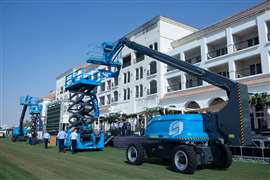DNV responds to Lebus concerns
25 August 2009
For a full report outlining Lebus' concerns, see the linked article or the text immediately below the DNV statement, which follows.
DNV statement:
In general, DNV's approach for all our rule development and improvements are risk-based. The rule improvement scheme is based on the concept of adjusting our requirements according to research and development, experience collected through operational feedback, as well as isolated incidents.
Experience feedback and consequent studies of relevant scientific reports have, therefore, resulted in an increased scaling factor - or "C-factor" - for Lebus-grooved drums in our Standard for Certification No.2.22 Lifting Appliances.
DNV's Standard for Certification No.2.22 Lifting Appliances indicates the acceptable level of stress only. It is not meant to give instructions on optimal design solutions. It is up to the designer to apply the appropriate basis for more detailed calculations by means of handbooks, scientific reports, design standards, etc.
The revised "C-factor" of 3 is, therefore, intended to give a conservative approach. Calculations, when thoroughly documented, may very well justify lower C-factors than 3 (this is clearly expressed in Standard No. 2.22).
DNV is confident that major parts of the industry agree on the fact that the use of thicker and stiffer wire ropes and larger winch drums, as applied in the deepwater operations, has initiated the need for new and revised winch drum requirements.
It can be mentioned that the large Austrian crane manufacturer, Liebherr-Werk Nenzing, in a presentation by Walter Länge, managing director, addressed this topic at the Offshore Crane Conference in Stavanger, Norway, in April 2009. Mr. Länge, in his presentation, indicated that the C-factor should be increased even further; to a value of 4. Likewise, Professor Dietz of Clausthal University of Technology, Germany, addressed the topic at the IMCA Winch Drum Workshop in July 2009, indicating a C-factor of 5.
In consequence, then, DNV 's adjustments of the C-factor has been well perceived and welcomed by major part of the industry.
With respect to addressing Lebus grooving only, please note the following:
* All DNV-approved winch drums for deep sea operations apply Lebus-grooved drums. As far as we know, other types of drums (conventional helix grooves and plain drums with spooling device) are not suitable for this type of operations.
* The Lebus solution is widely used and well known in the market. The term "Lebus" is synonymous with the specific solution of reeled drums in question. By using the term "Lebus", our standard addresses a design rather than a brand.
One of DNV's most important roles is to continuously update our rules and requirements to improve components and systems and to protect against undesirable events. In the next revision of our Standard No. 2.22 we will further revise the text and requirements, keeping it updated according to the latest knowledge and experience - including feedback from Lebus and other customers.
As said upfront, it is our role to listen to and to use experience from the industry to improve the standards, but it is at least as important to take care of the independent role DNV has when striving for continuous improvements to safeguard life and properties.
The text of the original Lebus story, New deep water lifting guidance criticised, is also reproduced below:
Lebus International Engineers has claimed that new guidance to limit the use of some deepwater cranes to 58% of their rated capacity will throw the industry into turmoil.
The guidance from certification and standards agency DNV follows a winch drum failure last year in which a flange broke, explained Lebus, a producer of multi-layer spooling winches. As a result, DNV revised its recommended safety factors for calculating stress imposed on the flanges of winch drums.
While the safety factor for drums with conventional helix grooves remains unchanged - 1 for one layer of rope, 1.75 for two layers or more - DNV has targeted Lebus-style grooved drums for an increase in the safety factor, said the company.
When using Lebus-style grooved drums with five or more layers of wire rope, DNV's recommended safety factor has been increased from 1.75 to 3. Lower factors may only be applied if there is thorough documentation, states the revised version of DNV's Standard for Certification No.2.22 Lifting Appliances.
Lebus claims that DNV's response is too simplistic and lacks scientific research. "Furthermore, it is causing unnecessary disruption to offshore lifting activities, with many cranes now unable to be used for the purposes for which they were originally specified," added the company.
"It is not clear why DNV has targeted Lebus grooving for higher safety factors than conventional helical grooving," said Cris Seidenather, Lebus managing director. "The same pressures are exerted on the flanges regardless of groove pattern. The only difference is that the Lebus pattern has been proven over the years, and this is well accepted by engineers and lifting contractors, to ensure much smoother spooling in multi-layer applications. It is an inherently safer design."
"We understand that DNV needed to respond to concern, and sympathise with the pressures they are under. However, more work is required to refine this guidance. Stresses on the flange are very complicated to calculate," Seidenather continued.
"DNV has produced this new formula without a proper scientific basis. Other factors need to be considered, including drum construction - whether the flanges are welded or bolted - and the type and construction of the wire rope being used, in particular its modulus of elasticity," added Seidenather.
Cris Seidenather adds: "Offshore contractors are working in deeper and deeper waters, lifting heavier equipment down to ever deeper depths. Now they are effectively being told they cannot do this anymore. To follow DNV's new rules would require making the lifting equipment so big that it would simply be uneconomic. No one could afford to buy it."
The International Maritime Contractors Association has set up a Crane & Winch Deep Water Operations workgroup in response to the crisis. Lebus has joined this workgroup to help the industry find a way through this crisis.
"We want to work with contractors to help DNV produce the most appropriate guidance for lifting equipment, and we invite anyone concerned about this issue to contact us directly," Cris Seidenather concludes.






